Photo
By 1st December 2019, the Ásatrúafélagið membership had reached 4,723.

Iceland’s Asatru Fellowship, Ásatrúarfelág, report their membership, by the end of September 2015, had grown to 3,101.
This is now very nearly 1% of the population and growing fast. In proportion to their populations 1% would be about 600,000 in the UK and about 3 million in the USA.
Seen above, offering a ceremonial libation, is the Society’s best known face and spokesperson Allsherjargoði (Chief Priest) Hilmar Örn Hilmarsson.
http://asatru.is/
Picture: mbl.is
44 notes
·
View notes
Photo
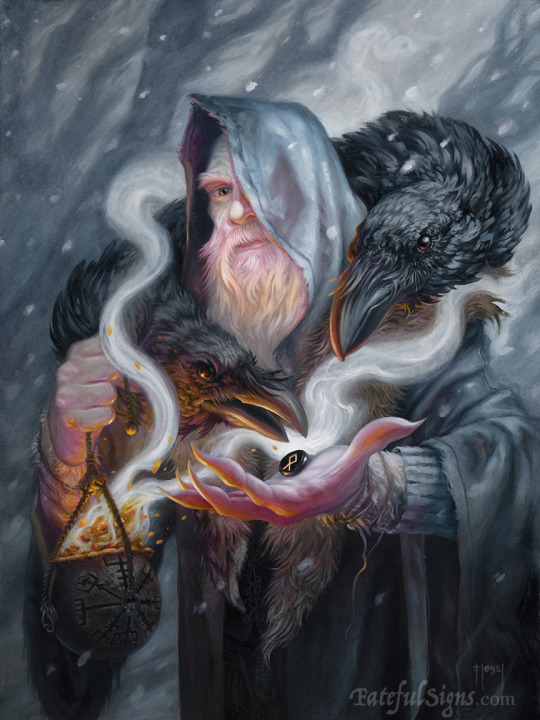
https://www.fatefulsigns.com/
Odin as Shaman
“Then began I to thrive, and wisdom to get,
I grew and well I was;
Each word led me on to another word,
Each deed to another deed.”
– Hávamál, Verse 142, Bellows Translation
Odin is a powerful sorcerer, in all the nine worlds there are none such as he who has mastered all the different forms of magic. He uses his two ravens to send out his senses to observe the different realms. He understands the depth of the runes and uses their power to gain more knowledge.
He uses Seidr, magic normally reserved for women, and some would say this makes Odin “un-manly.” However, he does not care what others might say. To Odin power is power. He uses Galdar to chant and sing the various sounds of creation, enacting his will on the different worlds. Finally, to him is reserved secrets of sorcery that no other can comprehend, simply whispered as Odinic Sorcery.
There are many forms of magic, and Odin practices them all. Knowledge is power, but it also has its price. What price would you pay?
The original painting was done in oil and measures 12" x 16". Thirty LE prints have been created for “Odin as Shaman.”
44 notes
·
View notes
Photo
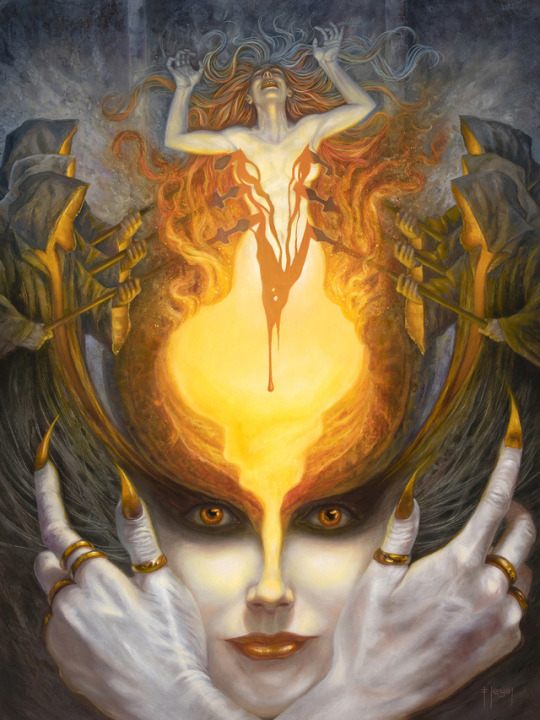
https://www.fatefulsigns.com/
Gullveig, Thrice Born
“The war I remember, the first in the wold,
When the gods with spears had smitten Gollveig,
And in the hall of Hor had burned her,
Three times burned, and three times born,
Oft and again, yet ever she lives.
Heith they named her who sought their home,
The wide-seeing witch, in magic wise;
Minds she bewitched that were moved by her magic,
To evil women a joy she was.
– Voluspa, Verse 21-22, Bellows Translation
Gullveig is a powerful being from Norse Mythology, but she is only mentioned in the Poetic Edda, specifically the Voluspa. At first glance this verse might seem like it is about witch burning, but on deeper inspection it is much more. Gullveig means something close to “Gold Might.” As the symbol of gold she has been burned 3 times, refined, and emerges as Heith, “Shining One,” becomes a powerful magic user and spreads joy among evil women. (You know strong women who think for themselves!) 😉
As you face the fires that life brings you, remember Gullveig. I hope that like her, you emerge a shining one!!!
70 notes
·
View notes
Photo
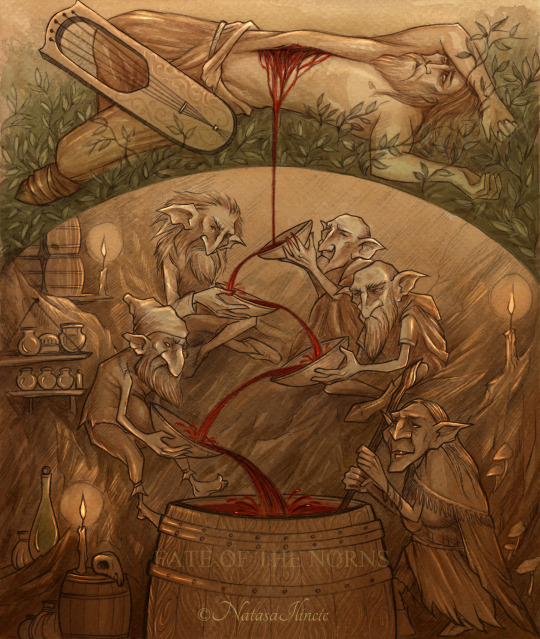
The Death of Kvasir and the creation of the Mead of Poetry.
Ink, watercolour, ps.
Featured in The Illuminated Edda.
#Kvasir#Mead#Heathenism#Odinism#Ásatrú#Norse Mythology#Viking Religion#Germanic Mythology#Norse paganism#artwork#Mythology#Mead of Poetry#The Inspiration of the Gods
2K notes
·
View notes
Photo
First posted May 2017








Under construction: Icelanders’ first Main Hof or Heathen Temple since their pagan Viking ancestors were officially Christianized about 1000 years ago.
After a long wait, the Hof will hopefully soon be in use and we’ll see libations offered there to Odin, Thor, Frey, Freyja and all the Gods and Goddesses, along with concerts, events and rites of passage, weddings etc.
These pictures were all taken by, or published by, the Hof´s Architect Magnús Jensson, a member of the Ásatrúarfélag, or Ásatrú (Norse Heathen) Fellowship, who will own and run the Hof. Pictures from top:
1: Artistic impression of completed Hof. 2: The site initially. 3: Ground work, autumn 2015. 4 :Timber (Larch) at the site Feb 2016. Pics 5, 6 & 7: recent work (April or May 2017). 8: an impresssion of the inverted dome. 9: Magnús.
#Ásatrú Hof#Ásatrú Temple#Asatru Temple#Heathen Temple#Iceland´s new main Ásatrú Temple#Temple to the Viking Gods & Goddesses#Ásatrú#Odinism#Heathenism#Norse paganism
638 notes
·
View notes
Photo
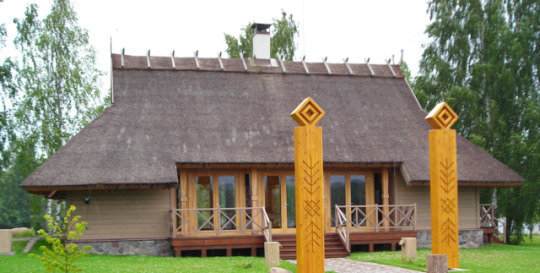


Many ancient Heathen Temples*, would have had much in common with this Latvian Neo-Pagan Temple though almost all would have lacked a flue or chimney, having just a smoke hole in the thatch above the central hearth and would not have had glass in the windows and doorways (just shutters and doors). But Scandinavian and Anglo-Saxon Temples would have contained a statue or statues of their patron God(s)** and could have been well lit by lots of then expensive candles and lamps for high days and holidays.
Small Temples would not always reflect a small population, a poor place or following: they would often have been mainly a home for the statues and other religious artifacts and would probably not have seen weekly or frequent “services”, but were often a focus for mainly outdoor public ceremonies and festivities on holidays which often would include sacrifice of wine, beer and beasts; feasting, dancing and merrymaking: particularly at Easter, Midsummer and Harvest Time***. Such temples would never have been as durable as stone, concrete or brick buildings like those in Greece and Rome and could easilly be destroyed by over-zealous missionaries and Christian rulers.
Latvian Paganism/Heathenism:
1) is one of the great family of religions that are closely or more distantly related to Odinism just as Indo-European languages are closely or more distantly related to one another.
2) Latvian Heathenism was one of the last European ethnic religions to be (almost) extinguished by Christianity: it lasted officially until the 19th C.
3) Latvia’s ethnic religion was further suppressed by the Soviet authorities when it was part of the USSR from about the end of WW2 until the Soviet Union collapsed. Soviet propaganda called it nationalist, racist and nazi. The fact that the Latvians, like Hindus, still used “swastika” or “swastika-like” symbols (as they had for thousands of years before the nazis existed) played into Soviet hands****.
4) The Latvian thunder God:
Thor-like images are carved into rocks and cave walls over large parts of Europe and go back many thousands of years and Latvia’s Thunder God, Perkūnas, is, in many ways like Thor.
5) Quote from Wikipedia:
“Baltic Neopaganism is a category of autochthonous religious movements which have revitalised within the Baltic people (primarily Lithuanians and Latvians). These movements trace their origins back to the 19th century and they were suppressed under the Soviet Union; after its fall they have witnessed a blossoming alongside the national and cultural identity reawakening of the Baltic peoples, both in their homelands and among expatriate Baltic communities. One of the first ideologues of the revival was the Prussian Lithuanian poet and philosopher Vydūnas.”
Read more:
https://en.wikipedia.org/wiki/Baltic_neopaganism
Notes:
* except for a few including the Great Temple at Uppsala in Sweden.
** According to Adam of Bremen, the Uppsala Temple contained statues of Odin, Frey and Thor (who sat in the central throne).
I include “Godesses” in the term “Gods”: it seems to me both more authentic and more egalitarian: the word “God” was neuter prior to Christianity and the word “Goddess” is a more recent coinage. Apologies to anyone who may have thought I am excluding some very loved female dieties including Freyja, Frigg and Sif.
***Yule festivities in midwinter would take place mainly indoors in private or in semi-private, notably in the large dwelling halls of the rich and famous, which is probably why Yule (celebrated now in English-speaking countries mostly under the name “Christmas”) has survived with more of its tradition intact, notably excepting the libations and overt mention of the Heathen Gods.
****In fact the Soviets, like the Church throughout most of its history before them, were much more racist: yes, they’d be (often in a very limited way) “inclusive” for individuals who would convert and mouth their own dogma back to them and nothing else, but would make sporadic efforts to cleanse the world of ethnic religions and persecute those who did not comply.
#Heathen Temples#Odinism#Heathenism#Latvian paganism#Latvian Heatenism#Latvian Neo-Pagan Temple#Old Uppsala#Anglo-Saxon Temples#North-European Heathenism#North-European paganism#Ethnic religions#Baltic Mythology#Baltic neo-paganism#Soviet suppression of ethnic religions
288 notes
·
View notes
Photo

This picture is a Swedish artistic impression of a great pre-Christian Hall or Temple at Gamla Uppsala. It is based on archæological findings.
A Great Temple at Gamla Uppsala is historically recorded as being where statues of the Gods Odin, Thor and Frey were housed and where the Goddesses were worshipped at Autumn Festivals.
#Gamla Uppsala#Pre-Christian Scandinavian Temple#Old Uppsala#Heathenism#North-European Heathenism#North-European paganism#Ásatrú#Odinism#Odin#Thor#Frey#Freyr#Viking Goddesses#Swedish Temple#Viking Temple
240 notes
·
View notes
Photo


The top picture shows a carving (believed to be of Odin) which is in Borgund Stave Church, Norway. The church itself is shown in the lower picture.
No Norse Heathen/pagan temples survive but I understand that these kind of stave churches are based on pre-Christian temples and this one obviously retains a connexion with the well-known Ásatrú God.
#Odin#Borgund Stave Church#Woden#Wotan#Odinism#Ásatrú#Asatru#Heathenism#Norse paganism#Viking religion#Norse Religion#Norway#Borgund#North-European Heathenism#North-European paganism#Germanic Religion#Germanic Mythology#Norwegian stave church
206 notes
·
View notes
Photo
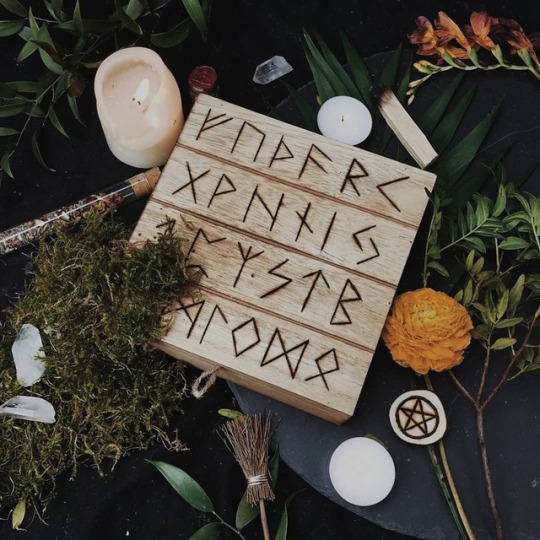

Spiced up one of my altar boxes with the elder futhark 🌱
✨ https://instagram.com/nordic.nymph
849 notes
·
View notes
Photo
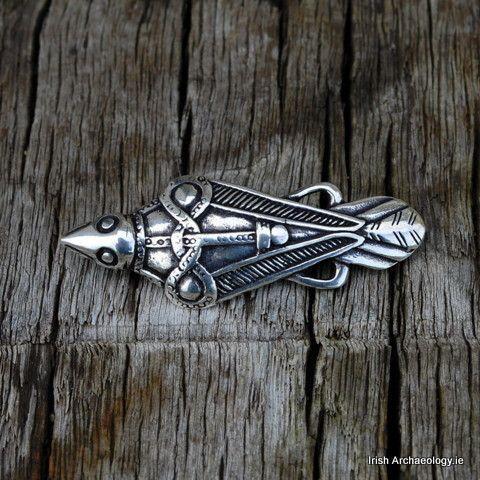
Fashioned out of sterling silver, this Raven Brooch is inspired by an original Viking Age find from Uppåkra in Sweden. In Norse mythology the god Odin was associated with a pair of ravens called Huginn and Muninn.
The brooch is available here: Silver Viking Raven Brooch
#Silver Viking Raven Brooch#Huginn & Muninn#Norse Mythology#viking religion#Odinism#Ásatrú#Archæology#Odin#Odin's Ravens#Viking Jewellery
129 notes
·
View notes
Photo

173 notes
·
View notes
Photo
Hugin & Munin: Odin’s Ravens, who collect information for him.


#hugin & munin#Odinism#Heathenism#Norse paganism#Viking religion#Germanic Heathenism#Odin's Ravens.#Norse religion
12K notes
·
View notes
Photo
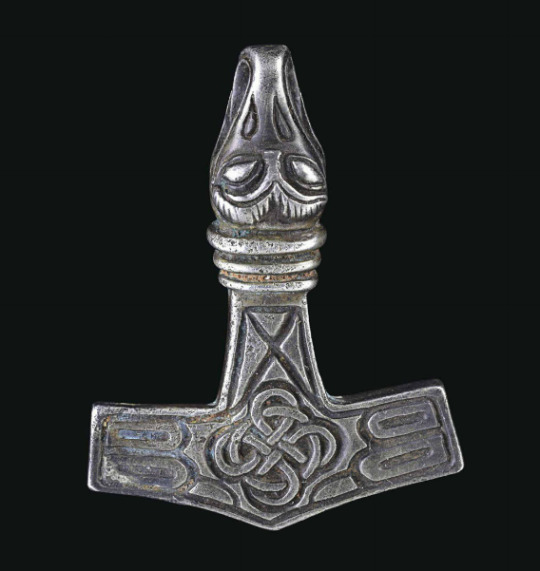
Viking Thor’s Hammer Pendant, 10th-11th Century
#10th - 11th Century Thor's Hammer Pendant#Thor's Hammer#Thor#Odinism#Heathenism#Ásatrú#Viking Pendant#Norse paganism
2K notes
·
View notes
Photo
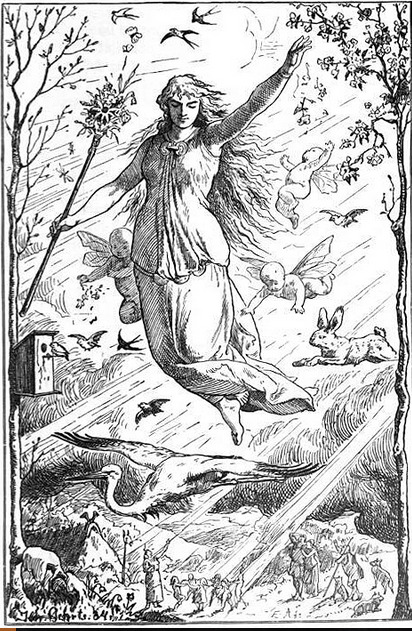
The Anglo-Saxon Goddess Ostara or Eostre after whom the seasonal celebration of Easter is named. (The early English also named one of their months after her.)
Important lore about her has been lost, as has much to do with other Goddesses (usually because of Christian distaste for femininity and fertility).
Nevertheless, many Heathen Easter traditions symbolizing fertility and renewal, including about hares and eggs and maypoles and storks have survived and these natural ideas and voluntary celebrations are more popular and more relevant for most people than the unnatural ideas of sin and torture in Hell that were for too long forced on whole populations.
Time to enjoy the fertility and feasting again:
Happy Easter!
Picture: Johannes Gehrts, 1884.
#Goddess Ostara#English pre-Christian religion#Eostre#Easter#Fertility Feasts#Odinism#Heathenism#Norse paganism#pagan Easter#Heathen Easter#Old English religion#Old English mythology#Germanic mythology#Ásatrú#North-European Paganism
133 notes
·
View notes
Photo
First posted January 2017
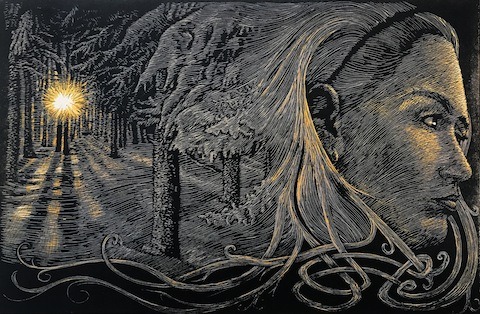
Chad Nelson’s winning entry in The Norse Mythology Blog’s recent Midwinter Art Competition: a woodcut depicting the Goddess Freyja in winter.
More about the competition can be seen at:
http://www.norsemyth.org/
#Freyja#Nordic Goddess#Viking Goddesses#Norse Mythology#Norse Religion#Odinism#Ásatrú#Norse Heathenism#Norse paganism#Vanir
113 notes
·
View notes
Photo
I don’t know about MORE recognition than Odin but Freyja IS highly important, and more important than Odin in many respects. She is my favorite Goddess.
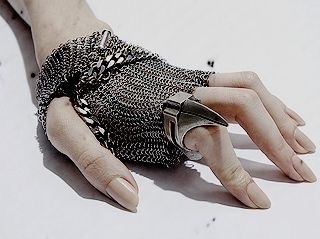
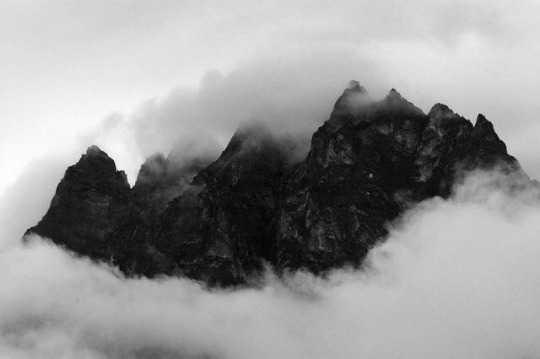
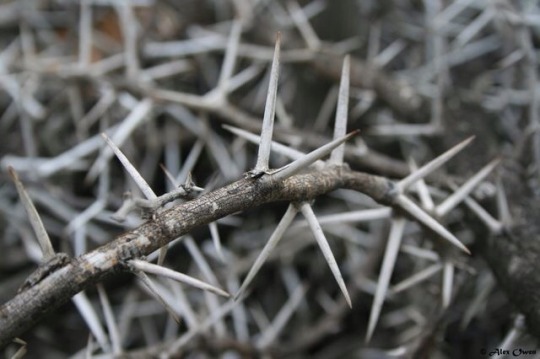
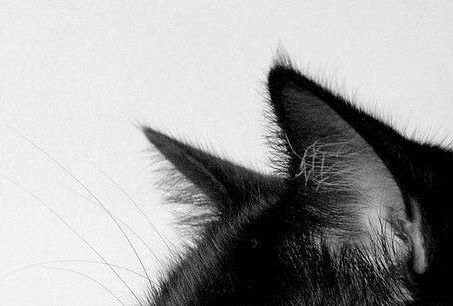
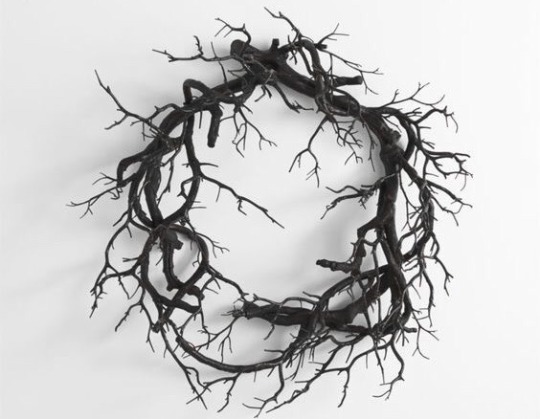

@femmefatalenet | event four | (freyja)
love is beautiful, but where it is, death follows.
freyja is the nordic goddess of love, fertility, war, and death. in a chariot pulled by cats, the ruler fólkvangr undoubtedly deserves more recognition than odin- as she gets first pick of the best warriors in asgard.
364 notes
·
View notes
